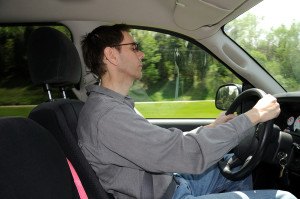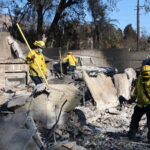Many of us make light of that relatively short drive home. But getting behind the wheel when you’re sleepy can cost lives and lead to imprisonment and a hefty fine.
 Drowsy drivers number in the millions. In a 2011 National Sleep Foundation poll, 60 percent of adults said they had driven at least once while drowsy, and 37 percent admitted to have actually fallen asleep at the wheel in the past year. AAA reports that one in six fatal traffic accidents results from drowsy driving.
Drowsy drivers number in the millions. In a 2011 National Sleep Foundation poll, 60 percent of adults said they had driven at least once while drowsy, and 37 percent admitted to have actually fallen asleep at the wheel in the past year. AAA reports that one in six fatal traffic accidents results from drowsy driving.
Sergio Bichao nearly added to those fatalities.
Motoring home in the twilight after classes at Rutgers-Newark, having been awake for more than 30 hours, he began to doze. Rather than pull over, he trudged on until he plowed into the back of another car carrying a young child.
He was shaken awake when his chest struck the steering wheel. “The windshield had shattered into a million pieces – the most frightening thing I had ever seen,” Bichao recalls. Miraculously, all escaped serious injury.
Like millions of others, Bichao – a student juggling classes, homework and editing the school newspaper – did not act on the signs that could have led to his death and the deaths of motorists in his path.
“When you are sleep-deprived for more than 24 hours, you need stronger sensory stimulation to maintain alertness,” explains Xue Ming, a sleep medicine doctor at Rutgers New Jersey Medical School in Newark. “Sensory input such as light, noise and touch keeps people alert, but when there’s little stimulation, the brain will drift into a full sleep state or a micro sleep, which can last from a fraction of a second up to 30 seconds. In this state, the person feels like he is awake – he might even still have his eyes open – but he is actually asleep.”
Since his accident, Bichao has been a one-person crusader for driving alertly. “I’ve talked to almost everybody I know about the dangers of drowsy driving,” he says. “I find that many people don’t realize or believe just how dangerous it is.”
Drivers are most vulnerable to drowsiness from 2 a.m. to 4 a.m. and 1 p.m. to 3 p.m., when their circadian rhythm – which regulates periods of sleepiness and wakefulness – dips. The circadian rhythm also prompts people to feel drowsy in diminishing daylight. “If a person had a big meal at lunch or did not sleep well the night before, this decline is more prominent,” says Ming, who stresses that shift workers are particularly vulnerable when they leave work in the early morning hours.
New Jersey became the first state to prohibit drowsy driving in 2003 when it passed “Maggie’s Law.” The law defines a motorist without sleep for more than 24 consecutive hours as a reckless driver who could face vehicular homicide charges, up to 10 years in prison and a $100,000 fine. The law recognizes that sleepy drivers demonstrate impaired judgment, slower reaction time, impaired coordination and increased aggressiveness.
Ming suggests a few tips to help enhance driving alertness for limited periods: a 20-minute nap, two cups of coffee or similar caffeinated beverage, brightening the dashboard or purchasing a visor light box that simulates morning light for the passenger side, since light boosts alertness.
“But, if you are feeling really tired,” Ming says, “the best thing to do is park your car and call a cab.”
Though we need seven to nine hours of uninterrupted sleep to feel fully alert, most Americans get six or fewer, Ming says. In fact, about 70 million Americans suffer from a chronic sleep disorder. The Centers for Disease Control and Prevention estimate that 8.6 million Americans take prescription sleeping pills, which might affect alertness and coordination.
“Sleep driving” grabbed headlines when Patrick Kennedy and Kerry Kennedy reportedly had Ambien in their systems in separate crashes in 2006 and 2012.
“It’s difficult to tell how a sleeping pill will affect an individual and how they drive the next day,” says Beatrix Roemheld-Hamm, associate professor, Department of Family Medicine and Community Health at Rutgers Robert Wood Johnson Medical School in New Brunswick. “For example, women typically are smaller than men, so the drug might affect them differently.” She notes that the FDA has warned people taking the longer-acting Ambien CR not to drive at all the following day.
Source: Rutgers Biomedical and Health Sciences
Was this article valuable?
Here are more articles you may enjoy.

 New Fire Maps Put Nearly 4M Californians in Hazardous Zones
New Fire Maps Put Nearly 4M Californians in Hazardous Zones  Catastrophe Experts Tap AI to Tackle Soaring Insured Losses
Catastrophe Experts Tap AI to Tackle Soaring Insured Losses  US Weather Service Merges Units as Staffing Pressure Rises
US Weather Service Merges Units as Staffing Pressure Rises  Novogratz’s Galaxy to Pay $200 Million in NY Luna Settlement
Novogratz’s Galaxy to Pay $200 Million in NY Luna Settlement 